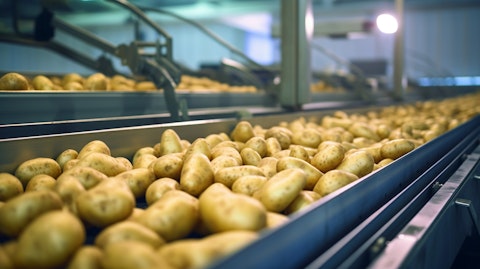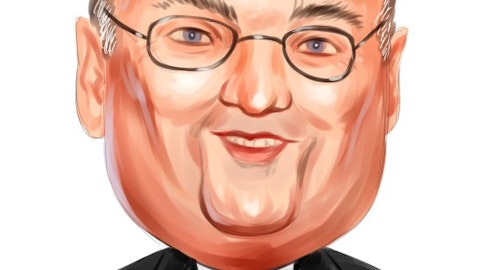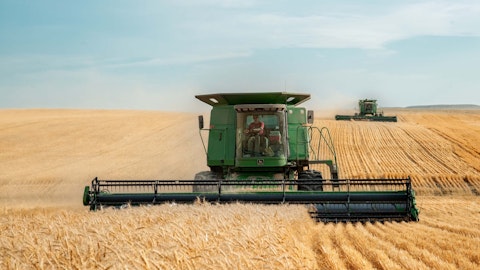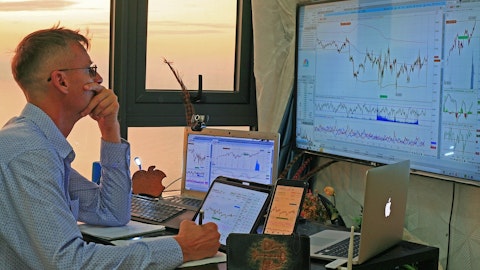Lamb Weston Holdings, Inc. (NYSE:LW) Q1 2024 Earnings Call Transcript October 5, 2023
Lamb Weston Holdings, Inc. beats earnings expectations. Reported EPS is $1.63, expectations were $1.09.
Operator: Good day, and welcome to the Lamb Weston First Quarter Earnings Call. Today’s conference is being recorded. At this time, I would like to turn the presentation over to Mr. Dexter Congbalay, VP of Investor Relations and Strategy. Please go ahead, sir.
Dexter Congbalay: Good morning, and thank you for joining us for Lamb Weston’s first quarter 2024 earnings call. This morning we issued our earnings press release which is available on our website lambweston.com. Please note that during our remarks, we will make some forward-looking statements about the company’s expected performance that are based on how we see things today. Actual results may differ materially due to risks and uncertainties. Please refer to the cautionary statements and risk factors contained in our SEC filings for more details on our forward-looking statements. Some of today’s remarks include non-GAAP financial measures. These non-GAAP financial measures should not be considered a replacement for and should be read together with our GAAP results.
You can find the GAAP to non-GAAP reconciliations in our earnings release. With me today are Tom Werner, our President and Chief Executive Officer; and Bernadette Madarieta, our Chief Financial Officer. Tom will provide an overview of the current operating environment. Bernadette will then provide details on our first quarter results, as well as our updated outlook for fiscal 2024. With that, let me now turn the call over to Tom.
Tom Werner: Thank you, Dexter. Good morning and thank you for joining our call today. We delivered a strong start to the year as we continued to execute on our strategies to drive sustainable profitable growth. Our integration of our EMEA operations is progressing well. Our capacity expansion in China is now up and running and our other expansion and modernization efforts around the globe remain on track. Our supply chain teams continued to drive productivity savings and our commercial teams remain focused on serving our customers and driving innovation across all channels. While our volume was down versus the prior year, it was in line with our expectations and was primarily driven by our decisions to exit lower-priced, lower-margin business.
We should see our year-over-year volume trends improve as the year progresses as we begin to lap and backfill exited volumes with higher-margin business. Overall, we feel good about the health of the category, our first quarter financial results, and our operating momentum, and have raised our sales and earning targets for the year. Let me now turn to the current operating environment. The global frozen potato category continues to be solid with overall demand and supply balanced. Fry attachment rates, which is the rate at which consumers order fries when visiting a restaurant or other food service outlets across our key markets have remained largely steady and above pre-pandemic levels. Restaurant traffic in our key markets was generally solid.
In the US overall restaurant traffic was flat versus the prior year quarter as QSR traffic growth offset further traffic declines in full-service restaurant channels. We believe that this is the cumulative effect of inflation and other macro pressures on the consumer over the past few years favoring QSR traffic and tampering full-service and casual dining traffic. While overall traffic growth did slow sequentially from about 1% in our fiscal fourth quarter as quick-service restaurant traffic growth cooled much of that weakness was in June and we are encouraged that both QSR and full-service restaurant traffic trends improved as the quarter progressed. In Europe, restaurant traffic grew in many of our key markets. In the UK, traffic was up mid-single-digits with growth in both QSR and full-service restaurants.
Growth was also solid in France, Germany, Italy and Spain. In Asia, China restaurant traffic growth was very strong, but of depressed levels as a country rebounded from the severe COVID-related restrictions. Traffic in Japan was solid in both QSR and full-service restaurants. We suspect that restaurant traffic trends will be volatile in the near term as high interest rates, high inflation and uncertainty continues to affect consumers. That said, frozen potato demand has proven resilient during the most challenging economic times and we continue to be confident in the long-term growth prospects of the global category. Now with respect to cost, we continue to expect input cost inflation in the mid-to-high single-digits, largely driven by higher contract prices for potatoes, including a 20% increase in North America and a 35% to 40% increase in Europe.
Much of our inflation-driven pricing across our channels has either already been announced or included in price escalators within existing contracts. Customer contracts representing about 20% of our North American business are in the process of being finalized and we feel good in the aggregate about the likely pricing and terms. Over the long term, we continue to expect pricing actions and supply chain productivity improvements will be the primary levers to offset inflation. We will also continue to drive improvements in product and customer mix to benefit sales growth and profitability. Now with respect to the upcoming potato crop. We are harvesting and processing the crops in our growing regions in both North America and Europe and we believe the crops in the Columbia Basin, Idaho, Alberta and the Midwest are in line with pre-pandemic historical averages.
In Europe, we believe that the crop will also be in line with historical averages as a result of improved growing conditions. We will provide our final assessment of the crop, including how it performs out of stores when we report our second quarter results in early January. So in summary, we delivered solid results in the first quarter and continue to have good operating momentum. The overall category remains healthy with demand and supply largely balanced. And finally, at this time we believe the potato crops in our growing regions in North America or in Europe will be in line with pre-pandemic averages. Let me now turn the call over to Bernadette.
Bernadette Madarieta: Thanks, Tom, and good morning, everyone. I want to start off by thanking the entire Lamb Weston team for the strong start to the year. Our performance speaks for itself and it’s a testament to the passion and dedication of our entire Lamb Weston team. We recognize that we are operating in a challenging macro-environment, but the strong first quarter performance has allowed us to raise our fiscal 2024 financial targets. Let’s start with reviewing our first quarter results. Compared with the prior year, sales increased $540 million or 48% to about $1.7 billion. About $375 million or 70% of the increase was attributable to the incremental sales from acquisitions with most coming from our EMEA business. We lapped our Argentina acquisition this quarter, but we’ll continue to receive the incremental benefit from the consolidation of the EMEA operations in the second and third quarters.
As a reminder, since we began to consolidate EMEA’s sales beginning in the fourth quarter of fiscal 2023, those results are included in our last year’s sales baseline. Excluding the incremental sales from our acquisitions net sales grew 15%; price-mix was up 23% as we benefited from the pricing actions taken in fiscal 2023 in both our North-America and International segments to counter input and manufacturing cost inflation. Mix was also favorable, as we continue to strategically manage our product and customer portfolio. In addition, we estimate the price-mix in the quarter benefited by a couple of percentage points from lower-than-expected trade spending associated with pricing actions that we began implementing in the last month of fiscal 2023.
This may be largely timing-related. And as a result, could be a slight headwind as the year progresses. The trade spend benefit in the quarter, however, was mostly offset by roughly two point headwind related to lower freight charges passed on to customers as transportation costs have come down from the prior year period. As a reminder, our goal is to match freight charges to our customers with our transportation costs, so that their effect on our profits is neutral over time. In-line with expectations overall sales volumes declined 8%. The decline was primarily due to our decisions to exit volume-related primarily to four of our lower-priced and lower-margin contracts as part of our revenue growth management initiatives and to a lesser extent continued inventory destocking by certain customers in international markets and in select US retail channels also impacted volume.

Potatoes being sorted on a conveyor belt in a modern packing facility.
We believe the effect of these destocking actions is largely behind us and should have little impact, if any, on our results going-forward. It’s important to note that volume elasticities or the amount of volume lost in response to inflation-based pricing actions have been generally low. We expect our year-over-year volume trends to improve as the year progresses as we lap the volume we exited and backfill volume with higher-margin business. Moving on from sales. Gross profit in the quarter excluding comparability items increased $213 million to $490 million. Nearly three-quarters of the increase was driven by the cumulative benefit of pricing actions, the timing of trade spending, mix improvement, and supply chain productivity in our legacy Lamb Weston business, which more than offset higher input and manufacturing cost per pound and the impact of lower volumes.
The remaining roughly one-quarter of the increase was attributable to incremental earnings from consolidating EMEA. Including the dilutive impact of the EMEA acquisition, our gross margin percentage, excluding comparability items, increased 480 basis points to 29.4%. While first quarter margins have historically been our lowest margin quarter, we estimate that the timing of trade spending that I mentioned earlier, accounted for approximately 200 basis points of the increase, which would put our normalized first quarter gross margin, including acquisitions, approaching 28%. Input costs continued to increase mid-to-high single-digits on a per pound basis. The increases were largely driven by a 20% increase in the contracted price for potatoes in North America.
Higher prices for open market potatoes due to poor yields from the 2022 crop and continued increases in the cost of labor, energy, and ingredients for batter coatings. The increase was partially offset by supply chain productivity savings, lower costs for edible oils, and lower freight costs. SG&A, excluding comparability items, increased $45 million to $160 million. More than half of the increase was from incremental SG&A with the consolidation of EMEA. The remainder was largely driven by higher expenses related to improving our IT and ERP infrastructure, and to a lesser extent higher compensation and benefit expenses and higher advertising and promotion expenses. All of this led to adjusted EBITDA increasing 76% to $413 million. Higher sales and gross profit in the base business drove most of the growth with the remainder attributable to incremental earnings from consolidating EMEA.
Moving to our segments. This is the first quarter that we operated in our two new reporting segments, North America and International. Beginning with our North America segment, which includes sales to customers in all channels in the US, Canada and Mexico, sales were up 19% in the quarter. Price mix was up 24%, which was driven by the carryover benefit of pricing actions that took effect in fiscal 2023, across each of our primary sales channels, the timing of trade spending, and favorable mix as we benefit from our revenue growth management initiatives. Lower freight revenue partially offset the increase. Volume in North America declined 5%. This primarily reflects our decision to exit volumes related primarily to two lower-priced and lower-margin contracts that largely began to impact our sales in the second and third quarters of fiscal 2023.
To a lesser extent, inventory destocking by certain customers in retail channels also pressured volumes. We don’t anticipate further effects from the retail destocking after the first quarter. North America segment adjusted EBITDA increased $148 million to $379 million as the carryover benefit of pricing actions, the timing of trade spending, and favorable mix more than offset higher cost per pound and the impact of lower volumes. Moving to our International segment, which includes sales to customers in all channels outside of North America. Sales grew $360 million or 212% and included $375 million of incremental sales from the EMEA and Argentina acquisitions. Excluding these acquisitions, net sales declined 9% while price mix was up 18% driven by the carryover benefit of pricing actions taken in fiscal 2023, as well as favorable mix, lower volume, and freight revenue offset the increase.
As expected, volume, excluding acquisitions declined 27%. The decrease primarily reflects our decision to exit two very low-price, low-margin accounts that largely began to impact our international sales volumes in our fiscal fourth quarter of 2023. To a lesser extent, continued inventory destocking also impacted volumes in the quarter, but as I mentioned earlier, we believe the effect of destocking is largely over. Despite a 27% decline in our International segment’s volume, segment adjusted EBITDA increased $57 million to $90 million. Incremental earnings from the consolidation of EMEA’s financial results as well as favorable price mix drove most of the increase, more than offsetting the impact of higher cost per pound and lower volumes in our legacy Lamb Weston business.
Moving to our liquidity position and cash flow. We continue to maintain a solid balance sheet with ample liquidity and a low leverage ratio. We ended the quarter with more than $160 million of cash and no borrowings under our $1 billion US revolver. Our net debt was about $3.3 billion, which puts our leverage ratio at 2.3 times. We generated about $335 million of cash from operations, or about $140 million more than the prior-year quarter, largely due to the higher earnings. Capital expenditures were about $305 million, which is up about $180 million from the prior year quarter, primarily due to construction costs as we continue to expand processing capacity in China, Idaho, Argentina, and the Netherlands. During the quarter, we returned more than $140 million of cash to our shareholders, including $41 million in dividends.
Most of the cash return was from repurchasing $100 million of shares. That’s more than double what we repurchased in all of 2023 as we acted opportunistically based on our stock price performance during our August open trading window. While our share buyback program is targeted to offset annual equity compensation dilution, we will continue to be opportunistic based on other capital allocation needs and the potential for generated solid returns based on our stock’s trading value. Turning to our updated fiscal 2024 outlook. Based on our strong first quarter performance, we raised our financial targets for the year. While we continue to expect macro operating conditions to remain challenging, the overall current demand and pricing environment remains solid.
In addition, as Tom mentioned, we believe the potato crops in our growing regions in North America and Europe will be consistent with pre-pandemic historical averages and we are generally pleased with how the discussions to renew remaining contracts are progressing in aggregate. Specifically, we continue to expect strong net sales gains for the year and have increased our annual net sales target to $6.8 billion to $7 billion, which is up from our previous target of $6.7 billion to $6.9 billion. This includes $1.1 billion to $1.2 billion of incremental sales attributable to EMEA during the first three quarters of the year, which is up $100 million from our previous estimate. This represents a 6.5% to 8.5% net sales growth, excluding acquisitions.
For the year, we are targeting price mix to be up low-double-digits, which means that we expect price mix will slow sequentially from the 23% increase that we delivered in the first quarter as we begin to lap some of our price actions that we began implementing in the second quarter of last year. While the overall potato category continues to be solid, due to the timing of contract openers, we are targeting our full year volume excluding acquisitions to be down mid-single-digits compared with the prior year. And we expect year-over-year volume trends will continue to improve as the year progresses, as we lap some of the significant low-margin, low product profit volume that we chose to exit in the second half of last year and as we gradually backfill the exited lower-margin business with more profitable business.
For earnings, we’ve raised our adjusted EBITDA target by about $90 million to $1.54 billion to $1.62 billion, up from our previous estimate of $1.45 billion to $1.525 billion. Using the midpoint of this updated range implies growth of about 26%, or about $330 million versus the prior year. We left our target for SG&A unchanged at $765 million to $775 million. While our first quarter run rate suggests a lower target, we continue to anticipate spending will build as the year progresses. We reduced our interest expense target by $10 million to $155 million as we expect to partially offset cash interest with more capitalized interest associated with our capacity expansions. Our other financial targets remain the same, including depreciation and amortization expense of approximately $325 million and capital expenditures of $800 million to $900 million.
In summary, we are executing our strategies to deliver strong top and bottom-line growth by improving our customer and product portfolio mix and offsetting input cost inflation through pricing actions and driving productivity savings across our supply chain. Volume elasticities in response to inflation-based pricing actions have been generally low, and we expect volume trends to improve as the year progresses. While we remain cautious about the effect of inflation on the consumer, we feel good about the start of the year and the health of the category, which gives us the confidence to raise our full year sales and earnings targets. And with that, let me now turn it back over to Tom for some closing comments.
Tom Werner: Thanks, Bernadette. We delivered a strong quarter, and our operating momentum has us well-positioned to deliver another year of solid sales and earnings growth. In addition, we are confident in the health of the global category and remain committed to investing in our business to drive sustainable profitable growth and create value for our shareholders over the long-term. And, finally, as you may know, we will be hosting an Investor Day on Wednesday, October 11th at the New York Stock Exchange. During the presentation, we’ll discuss our view of the industry, our strategies for growth, and our long-term financial targets and capital allocation policies. If you haven’t already, please register if you plan on attending in-person as space is limited. Otherwise, you can view our presentation via our webcast, which you will be able to access through our website. Thank you for joining us today. Now, we are ready to take your questions.
See also Wind Power by Country in 2023: Top 15 and Top 25 Digital Countries in the World.
Q&A Session
Follow Lamb Weston Holdings Inc. (NYSE:LW)
Follow Lamb Weston Holdings Inc. (NYSE:LW)
Operator: [Operator Instructions] And we’ll take our first question from Peter Galbo with Bank of America.
Peter Galbo: Hey, guys, good morning. Thanks for taking the questions.
Tom Werner: Good morning.
Bernadette Madarieta: Good morning.
Peter Galbo: Tom and Bernadette, thank you both very much for the color around price mix and volume for the year. Tom, I was hoping to ask maybe a two-part question on volume. One, just maybe help us a little bit with cadence on when some of these backfill higher-margin customers potentially start to come online for you? And then, Bernadette, I know you kind of gave order of magnitude on International, but if there’s anything more a finer point on volumes between just what was intentional walk away versus the destocking impact in a quarter would be helpful? Thanks very much.
Tom Werner: Yes. So, Peter, this is Tom. So, as Bernadette alluded to, it was limited to four accounts, and you know it was important for us to maintain our pricing discipline. One of the accounts in International specifically, we are losing money on. So it was time just to part ways and that had a big impact on our International volume. So, it was a measured discipline action we did and the thing in terms of your — the first part of your question, we have line-of-sight to backfilling that volume, it does take time, it’s not a linear match when you walk away. Been through this before, but we have a great commercial team that has identified a number of opportunities in the market in both North America and International, and we are actively working at.
And as we stated in the prepared remarks, volume is going to be sequentially getting better over the next quarter and the back half of the year. We expect the categories — and, really, it’s in good shape. So between organic growth and some things that we have identified, I feel great about where we are at and how we are going to execute and continue to grow the volume in the back half of the year and over the course of the next several quarters.
Bernadette Madarieta: Yes. And Peter just to the —
Peter Galbo: Got it.
Bernadette Madarieta: To the second question you asked, you know that those volume exits started impacting our International sales in our fiscal fourth quarter of 2023, and the business that we chose to walk away from, I would say about 90% of that relates to that in terms of volume decline with the remainder of being the destocking.
Peter Galbo: Got it. Very helpful. Thank you. And then, Tom, one question I have just been getting on the crop itself. Obviously, the crop in your main regions is coming pretty well. I think, there has been some issues in the East Coast Canada crop. Just curious kind of how you think that might impact the overall category here over the course of the next year in terms of the industry tightness? Thanks very much.
Tom Werner: Yes. Peter, I think, the crops — and we will have a — as we do every January on our earnings call, kind of a debrief on how we are feeling about the overall crop and storage, crop is in great shape worldwide. So, I don’t expect any impacts in any region in terms of challenges with the crop at this point.
Peter Galbo: Thanks very much, guys.
Tom Werner: Yes.
Bernadette Madarieta: Thank you.
Operator: We’ll now take our next question from Tom Palmer with J.P. Morgan.





